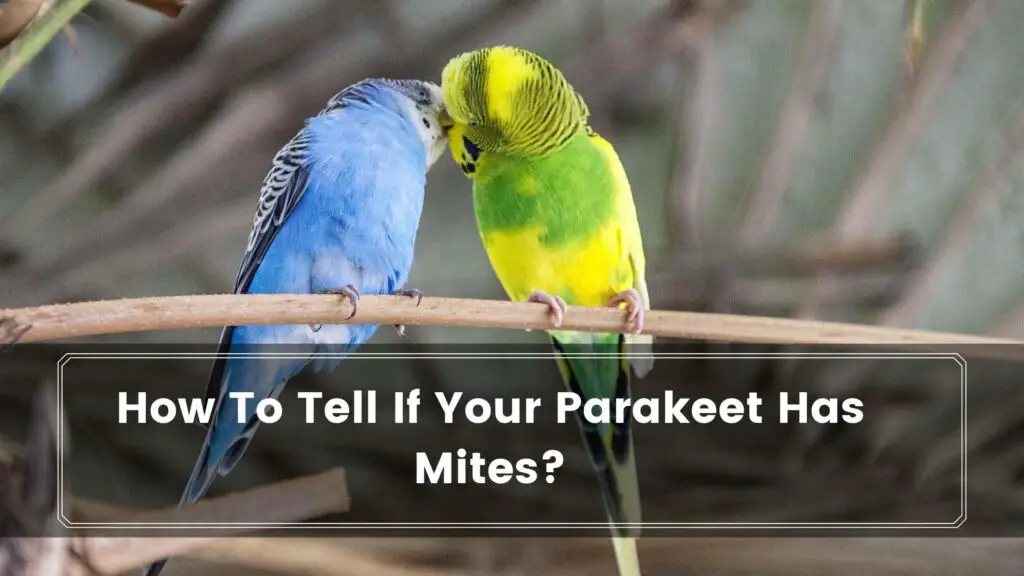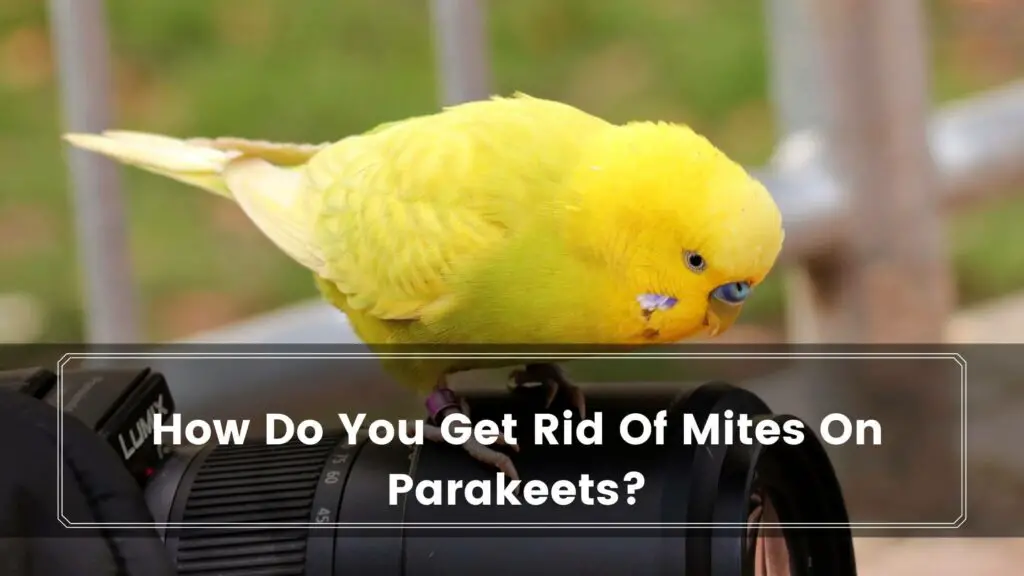
As with every other species of bird, parakeets also suffer from mites. It’s crucial to be aware of what you need to do if your bird is suffering from mites. Mites are parasites external to the bird that promptly requires treatment as they can cause parakeets to be highly sick within a short period.
Mites feed primarily on the blood of parakeets and can survive indefinitely if your bird isn’t treated. While mites feed on the blood of birds, they’ll surely be dead within 21 to 28 days if they do not have any source of bird blood.
As a responsible owner, the most effective preventive measure is to avoid infestation. First, we must determine if our parakeets are infested with mites. So, here is How To Tell If Your Parakeet Has Mites?
How To Tell If Your Parakeet Has Mites?

Here are 5 symptoms and signs of being looked for to identify the parasite found on parakeets.
- The Parakeet appears to be preening and restless during the night.
Mites typically feed on the blood of birds during the night, making it possible that your pet will overindulge in preening. At night, Parakeets are often seen becoming restless and angry due to the bites of mites.
If you see your Parakeet licking its skin or squirming excessively, it is likely to be a victim of mites. Parakeets usually attempt to get rid of the mites to get to the skin and affected areas, but in many cases, this is not helpful. Mites are not eliminated by grooming or preening excessively.
- Parakeet’s Skin is scaly & irritated.
Another thing that you must pay focus on is your bird’s legs. If you notice, their legs are extremely dry and have a white crust that’s an alert red. If the mites are not treated and allowed to get from the skin, their legs may appear to be swelling with numerous eruptions.
This is often scaly leg mites. The Parakeet is likely to begin losing feathers on its leg and skin. If left untreated, the Parakeet could get crooked legs or even beak from external parasites quickly. If they suffer from an infection like this, your birds will likely suffer from extreme discomfort and itching.
- The Parakeet is scratching its body on the cage.
If you notice your birdss body scratching against the cage, then you must pay attention. Shortly, your parakeet will begin losing weight. This type of parasite affects birds’ feathers and makes their appearance dull. In addition, it’s typical to observe a parakeet pulling its feathers to remove the mites.
This means that you’ll see more feathers within the cage of your parakeets. If these parasites from the outside were given a chance to multiply, the marks of red on their skin could be evident. Red mites typically develop in birds with weak immune systems.
If you’ve fed the wrong kind of food or the exact one for a long time, then it may reduce your birds immunity. It is normal to see that a parakeet appears weak because of anemia brought on by the mites that feed.
- A thickened, swollen crust on the cere and the bills.
The mites of this kind are extremely difficult to identify since they are inaccessible to the human eye. Therefore, you can only rely on the symptoms and signs your parakeets’ display.
If you notice a thickening of the crust on their face, the bill, cere, or even their face, this is a red alert. It is essential to take this seriously as they’re called facial mites that burrow. These external parasites excel for digging through the skin of birds and creating a myriad of tunnels, which can be painful for parakeets.
- Your parakeet may be coughing and sneezing quite a lots.
Air sac mites commonly referred to as canary lung mites can be observed on parakeets. If your parakeet is often sneezing, it could be suffering from an infection in the form of Air sac mites. The mites cause a parakeet to gasp for air. If left untreated, the mites will not survive; the Parakeets will experience difficulty breathing.
It is also customary to observe a Parakeet emitting click sounds or changes in the sound they usually make. These mites excel at infecting the entire respiratory system and the tract of your Parakeet. These mites are discovered from the nose up to the air sacs in your Parakeet’s lung. It is rare to find evidence for air sac mites in parakeets because these parasites externally are more prevalent in finches and canaries.
Let’s look at how parakeets acquire mites. Also, we will learn how to eliminate parasites on parakeets.
How Do Parakeets Get Mites?
Parakeets are more prone to contracting mites than other bird species. They typically get Mites that have been ingested from deceased animals brought in by cats or another pet animal. Mites may also bite the Parakeet from birds that are infected too. Mites can’t be found in humans; however, they can be transmitted to an animal as a host.
Mites also excel at hiding inside furniture made of wood or upholstered. They seek out an active host or bird parakeets in the evening, which could be a target. It is crucial to properly clean your home and wash your hands properly before touching or touching several parakeets. Clean and proper sanitization is vital to minimize the chance of transmitting mites.
- Interesting Further Reading
- Can Parakeets Tolerate Heat? If So, How Much?
- All About Parakeets Making Noise & Sounds
- Can Parakeets Live Alone? + Do Parakeets Need a Companion
- All About: Parakeets Breeding Behaviour!
How Do You Get Rid Of Mites On Parakeets?

There are many DIY treatments; however, they will not eliminate all dust mites. However, they can help sufferers. Numerous products combat the problem of bird mites, but only a handful are considered safe or natural. However, be aware that these home treatments might work only for a brief relief.
To deal with it effectively and eradicate the mites, it is best to visit a veterinarian. In the case of severe problems, only a vet can prescribe the proper medication for your pet’s internal health. It is crucial to use vet-prescribed medication since the dosage is dependent on the bird.
A qualified veterinarian can prescribe external treatments with proper dosage guidelines to follow. Keeping your pet’s surrounding area clean is essential to prevent parasites. It is imperative to bathe your pet regularly. While bathing, ensure that the water is held to the chest to ensure your Parakeet security. It is essential to be aware of the Parakeet for mites and symptoms regularly to identify and treat them quickly.
This article has only covered the home remedies for short-term relief, and we do not intend to overrule or contest the advice and treatment provided by an accredited veterinarian. All products should be used in conjunction with a licensed doctor.
If an owner who is responsible notices that their bird has a mite, it is imperative to treat it as quickly as possible. If you spot a parakeet with mites, you must treat your bird’s cage and its surroundings. We will discuss three easy methods to deal with mites on parakeets.
Bathe your bird using an online dish shop. When bathing your bird, you must spray their surroundings and cage with top-quality Pyrethrin products. In this instance, I’d advise that you use the Scalex lice and mite spray since it has been proven to be the most efficient.
When bathing your pet using dish soap, clean them using an animal bathing product or a mild soap made of glycerine. It is recommended to spray your pet with Scalex lice and mite spray. Following spraying with this Scalex spray, apply the spray gently to the feather and skin of your pet. Your pet may take pleasure in this activity as it’s great for bonding.
Please make use of vinegar since it aids in treating itchy skin for a parakeet. To make an effective spray, you must make a vinegar mixture with salt water to create an amide attracting agent. You can also mix white vinegar and some drops of essential oil peppermint. The two sprays can be used as a potent insecticide for birds.
You could also use Dawn dish soap as the surfactants in the dawn soaps are highly efficient in eliminating and breaking down the exoskeleton of the mites. This treatment aids in stopping the growth of mites and thereby creating immunity. Always dilute the Dawn dishwashing soap with water and spray it in spray on your bird’s skin feather and the environment as well.
Summary
Many kinds of mites can harm your parakeet. The most frequent ones include air sacs, mites, facial mites with scaly skin, and the red night. To identify mites in a barricade, you need to look for scaly and crusty spots on the beak, the skin, and the eyes. Skin irritation or scaly patches on the legs could be signs of mites in the body of your Parakeet.
The parakeets suffering from mites tend to groom or groom themselves excessively during the night, when mites tend to be most active, feasting on the blood of birds. It is also customary to observe a parakeet frequently coughing or sneezing and breathing difficulties when infested by mites.
To get rid of the mites, it is essential to see your local specialist veterinarian and examine them. At first, home remedies can aid in the treatment of symptoms, but for effective treatment and to eliminate all the mites off their bodies, professional assistance from a veterinarian and administration is required. I have tried to provide you with all the details you need about parakeet mites. Check out our other valuable sources on parakeets as well.

Hi, There and Welcome to BirdsNews.com, is here to help you learn and care about pet birds. and this blog is a journal of everything I’ve learned.
